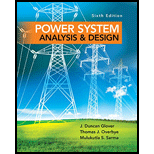
Concept explainers
A source supplies power to the following three loads connected in parallel: (1) a lighting load drawing
Trending nowThis is a popular solution!

Chapter 2 Solutions
Power System Analysis and Design (MindTap Course List)
- An industrial plant consisting primarily of induction motor loads absorbs 500 kW at 0.6 power factor lagging. (a) Compute the required kVA rating of a shunt capacitor to improve the power factor to 0.9 lagging. (b) Calculate the resulting power factor if a synchronous motor rated at 500 hp with 90 efficiency operating at rated load and at unity power factor is added to the plant instead of the capacitor. Assume constant voltage (1hp=0.746kW).arrow_forwardThe load at a certain factory consists of the following:10 kW, pf = 0.6 lagging15 kW, rf = 0.5 lagging25 kVA, pf = 0.75 lagging15 kVAR, pf = 0.8 lagging22 kW5 kVAR, pure inductance1. The power factor is to be corrected to 0.95 lagging. Determine the kVAR rating of pure capacitors needed to accomplish this.arrow_forwardA supply of 250 V, 80 Hz is connected across an inductive load and the power consumed is 2 kW, when the supply current is 10 A. Determine the following: 1.The value of capacitance (µF) connected in parallel with the load that is needed to improve the overall power factor to unity.arrow_forward
- A 3-phase, 50 Hz, 3000 V motor develops 600 H.P. (447·6 kW), the power factor being 0·75 lagging and the efficiency 0·93. A bank of capacitors is connected in delta across the supply terminals and power factor raised to 0·9 lagging. Each of the capacitance units is built of five similar 600-V capacitors. Determine the leading Kvar taken by each three sets.arrow_forwardA 550-V feeder line supplies an industrial plant consisting of a motor drawing 60 kW at 0.75 pf (inductive), a capacitor with a rating of 20 kVAR, and lighting drawing 10 kW. (a) Calculate the total reactive power and apparent power absorbed by the plant. (b) Determine the overall pf. (c) Find the current in the feeder line.arrow_forwardThe average load of a dairy plant at 11 kV, 50 Hz is 950 kW at 80 percent power factor but the maximum contract load of plant is 1200 kW. As per local electricity regulating authorities norms, consumer must keep the power factor of 95 percent to avoid any poor power factor penalty. Determine the following (i) Rating of capacitor bank (in kVAr) (ii) The capacitance of the capacitor bank (in micro Farad) (iii) Explain why the power factor becomes low and how the capacitor bank will assists to improve the power factor?arrow_forward
- When connected to a 120 V (rms), 60-Hz power line, a load absorbs 4kW at a lagging power factor of 0.8. Find the value of Capacitance, C, necessary to raise the power factor to 0.95 lagging.arrow_forwardA 5-ohm resistor is connected in series with a 25 micro-farad capacitor. A source voltage of158 volts, 50 Hz supplies the combination. Determine the following: e. Reactive power supplied by the sourcef. Apparent power of the circuitg. Power factor of the entire circuitarrow_forwardA series circuit containing a noninductive resistance of 3 Ω and a coil is connected to a 120 V, 60 Hz supply. The current is 25 A. The true power, as indicated by a wattmeter, is 2500 W. Determine: the power factor of the series circuit. the effective resistance of the coil. the impedance and inductive rea ctance for the coil. the power factor of the coilarrow_forward
- 2) The net inlet to a factory powered by a 2300 volt infinite busis measured as 765 A, for a lag 0.92 power factor. although mostloads is inductive, the input power factor has been improved by installing asynchronous capacitor operating at its nominal value of 1000 KVA. Determine the factor oforiginal factory power.arrow_forwardA series circuit consists of a resistance of 10 ohms, an inductance of 200/π mH, and capacitance of 1000/π μF. Calculate (a) the current flowing in the circuit if the supply voltage is 200 V, 50 Hz, (b) the power factor of the circuit, (c) the power drawn from the supply. Also, draw the phasor diagram.arrow_forwardIf a load absord 20KVA at the leading power factor of 0.6 Write the complex form of powerarrow_forward
 Power System Analysis and Design (MindTap Course ...Electrical EngineeringISBN:9781305632134Author:J. Duncan Glover, Thomas Overbye, Mulukutla S. SarmaPublisher:Cengage Learning
Power System Analysis and Design (MindTap Course ...Electrical EngineeringISBN:9781305632134Author:J. Duncan Glover, Thomas Overbye, Mulukutla S. SarmaPublisher:Cengage Learning
